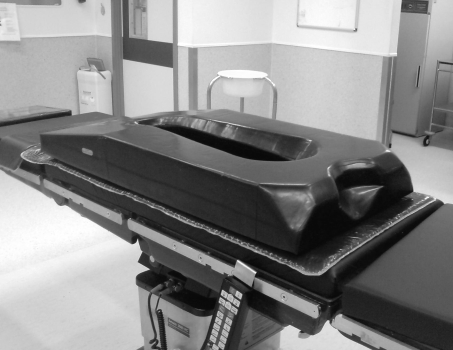BACKGROUND
Percutaneous nephroscopic procedures are carried out with the patient in prone position. The optimal method of prone positioning for any surgical procedure is determined by the necessity of providing good operating field with minimal thoraco-abdominal compression and with patient's head in neutral position.1 We describe our experience of using a mattress routinely used in spinal surgery, the ‘Montreal’ mattress (Teasdale Hospital Equipment, Manchester, UK) in performing percutaneous nephrolithotomy (PCNL).
TECHNIQUE
The ‘Montreal’ mattress (Fig. 1), which can be easily mounted on any operating table, is a rectangular mattress with a central hollow which helps to prevent compression of the abdomen during respiration and avoids interference with the venous return. It has a gutter at the head end to ensure mild flexion of the neck, assisting airway maintenance (Fig. 2). In our institution, we have used this mattress for positioning in 36 patients for PCNL without any complications and maintaining the pulmonary airway pressure below 30 cmH2O.
Figure 1.
‘Montreal’ mattress positioned on the operating table. The central hollow and the gutter at the head end are obvious. Flexion at the hips is facilitated by slight slope towards the lower end.
Figure 2.
Patient positioned using all the features of the mattress allowing optimal positioning of the neck for the airway.
DISCUSSION
During PCNL, the commonly used techniques of pillows or folded blankets placed under the iliac crests and chest leaving the abdomen unhindered are cumbersome and can cause alteration of the patient position during the operation leading to complications. The ‘Montreal’ mattress suggested to us by an anaesthetist with experience in spinal surgery is a simple and easy alternative with all the essential features. Usage of this mattress provides an example of sharing of knowledge between specialities and we strongly recommend the mattress for patient positioning during PCNL.
Reference
- 1.Schonauer C, Bocchetti A, Barbagallo G, Albanese V, Moraci A. Positioning on surgical table. Eur Spine J. 2004;13(Suppl 1):S50–5. doi: 10.1007/s00586-004-0728-y. [DOI] [PMC free article] [PubMed] [Google Scholar]




